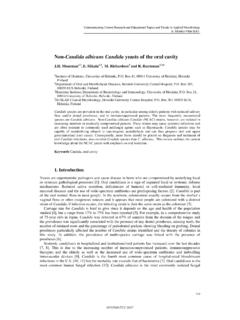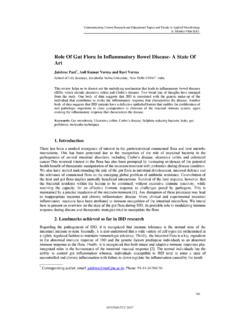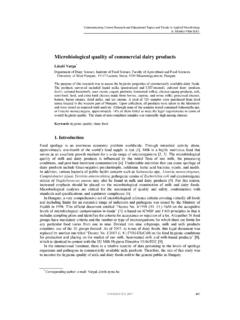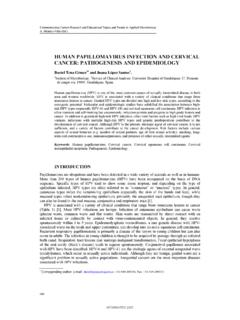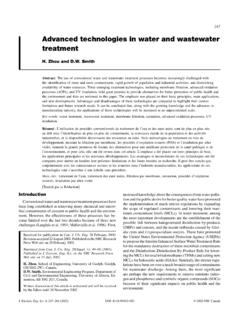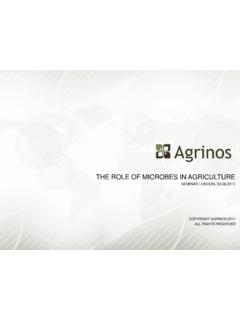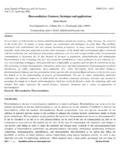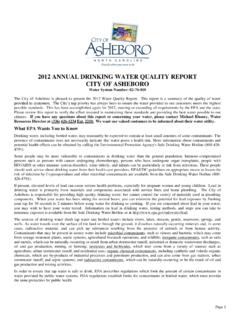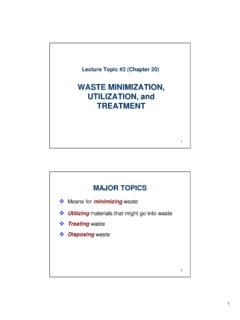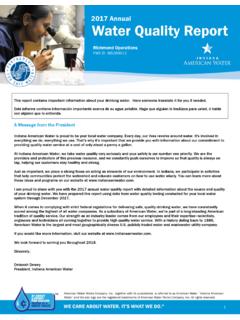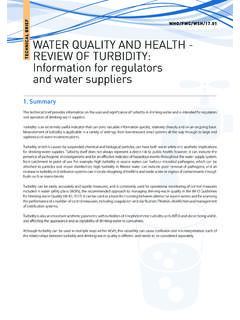Transcription of Microbial resources and industrial microbial processes ...
1 Microbial resources and industrial Microbial processes design and behavior M. Hamdi Laboratory of Microbial Ecology and Technology, Department of Biochemical and Chemical Engineering. National Institute of Applied Sciences and Technology. 1080 Tunis, Tunisia. e-mail: The large diversity in the microorganisms explain why they are involved in many industrial Microbial processes . The industrial Microbial processes concern fermented food preparations, Microbial cell and metabolite productions and wastes processing. They are made in fundamentally the same way with three steps: pretreatment of raw matter, Microbial conversion, and product recovery. The obtaining an efficient process is based on the control of the environmental conditions and the limiting substrate concentration influencing the Microbial metabolism.
2 Microbial process design should take into account specific biological and technological constraints and minimize the cost of product during production and downstream operations. Keywords: biodiversity; bioreactor; Microbial process; fermented food; metabolite; waste. 1. Introduction A large number of natural ecosystems are sites of impressive diversity of Microbial activities. Bioprocess engineering evolves from the use of biocatalyst activities especially microorganisms by scientists and engineers in order to obtain products or services [1, 2]. The industrial Microbial processes (IMP) resulted in the control of safety, mixing and environmental conditions and in the use of selected microorganisms to obtain higher productivity with lower cost.
3 They could contribute also to solve the problem of increased demand in the international market in natural products with good safety with respect to health and environmental restrictions. Innovative research is therefore urgent in order to establish technologies economically viable which operate on the spectrum of opportunities offered by microorganisms. From the gene to the production system, the bioengineering is under constraint of ecoethics, sustainability and public acceptance. The multi disciplinarily of bioengineers is related to the main rule of the optimization of the bottlenecks and the elimination of the extra and intracellular key process constraints. Microbial engineer includes the omics (transcriptome, proteome, metabolome, physiolome) under the effect Microbial populations, connected to macro, micro mixing and biological reactivities.
4 The education of Microbial engineering drives scientists and practitioners to conduct Microbial processes with innovative mind and high productivity. This paper present the integrated knowledge of Microbial resources and bioengineering necessary to the faster development cycle of industrial Microbial process and the generation of the appropriate manpower for society. 2. Bioengineering of diversified Microbial metabolism Microbial activities induce the microorganisms as dynamic entities and continually changing by transformation of essential and indispensable chemical elements assimilated from environment into Communicating Current Research and Educational Topics and Trends in Applied Microbiology A. M ndez-Vilas (Ed.)
5 426 FORMATEX 2007_____ constituents of which cell is composed. Schematically the catabolism produces energy by oxidation of catabolite substrate while the anabolic pathway built from substrates just the monomers, secondary biopolymers constituting the cell biomass (Fig. 1). Fig. 1. Mapping of the different barriers flux and actions controlling the genome expression source of bioproducts in industrial Microbial processes . The change of energy and carbon sources used gives a large diversity in the microorganisms and explain why they were presents during biosphere evolution and involved in many industrial Microbial processes and ecosystems [5, 6]. The oxidation of the catabolite substrate which is an electron donor requires some electron acceptors according Microbial groups (Table 1).
6 The synthesis of the high energy phosphate bonds in ATP resulted from the series of reactions involved in the oxidation of primary electron donor (PED) and the reduction of terminal electron acceptor (TEA). Energy is trapped largely as ATP either during oxidation at PED level, photophosphorylations or in oxidative phosphorylations which occur as hydrogen from the catabolite substrate is transferred to TEA [7]. Communicating Current Research and Educational Topics and Trends in Applied Microbiology A. M ndez-Vilas (Ed.)427 FORMATEX 2007_____Table 1: Microorganism major groups and their energy and carbon source, primary electron donor, and terminal electron acceptor The level of energy produced and kinds of intermediates which are responsible of coupling between catabolism and anabolism, are function of primary substrates concentrations and catabolic pathways on the one hand, and the biosynthesis pathways of cell constituents and anabolic metabolites on the other hand (Fig.)
7 2). Metabolites produced by Microbial metabolism were classified in three products according the coupling of energy-producing reactions with product-forming reactions [8]: (i) catabolic metabolite formation related to carbohydrate utilization, (ii) anabolic metabolite formation indirectly related to carbohydrate utilization during growth limitation, (iii) anabolic metabolite formation not associated with carbohydrate utilization. However at low growth rate, biomass formation becomes energetically more expensive and substrate flux is presumed to solely support maintenance demands [9, 10]. In deed, substrate limitation or stress conditions induce low growth rate because the uncoupling of energy-producing reactions with product-forming reactions.
8 Communicating Current Research and Educational Topics and Trends in Applied Microbiology A. M ndez-Vilas (Ed.)428 FORMATEX 2007_____ Fig. 2. General scheme of relationship between catabolic reactions and anabolic reactions in Microbial and the chemical energy coupling system between dissimilation, synthesis and maintenance. The control of the Microbial metabolism is essential component in the construction of industrial strains and in obtaining an efficient process. Metabolic engineering based on the advent of recombinant DNA technology and pathways control should offer new opportunities in the development of new products and in the improvement of productivity [4, 11, 12]. 3. bioreactor behavior and Microbial kinetics control The biochemical reactions involved in the Microbial cell growth, the metabolite production and the maintenance are under the control of the environmental conditions and the limiting substrate concentration.
9 However, the microorganisms used in the Microbial process are never under optimized conditions but rather under limitations and stressed conditions [11]. The models of consumption rate of limiting substrate used in the Microbial cell growth, the metabolites productions and the maintenance are the basis of the development of algorithms for processes and their applications to the control, of critical variables, , temperature, pH and nutrient addition, to optimize productivity [9, 13]. Environmental conditions The physico-chemical and mechanical parameters represent possible control environmental conditions in bioreactors. The cultivation of microorganisms requires appropriate culture media containing all chemical needs, and optimal physical conditions as temperature, pH, gaseous atmosphere and mixing.
10 The extracellular environment is more homogenous than intracellular environment, particularly the cytoplasm s elements change with extracellular environment as osmotic pressure, heat chock and physiological state of organism [14]. In deed, it remain hard work for cell structure in order to modify Communicating Current Research and Educational Topics and Trends in Applied Microbiology A. M ndez-Vilas (Ed.)429 FORMATEX 2007_____some barriers (compartments and fluids) which control the intracellular mass transport and then the biochemical kinetics. The Microbial cell freely suspended in a bioreactor often occurs in groups or flocs many orders of magnitude greater in size than a single microorganism.

